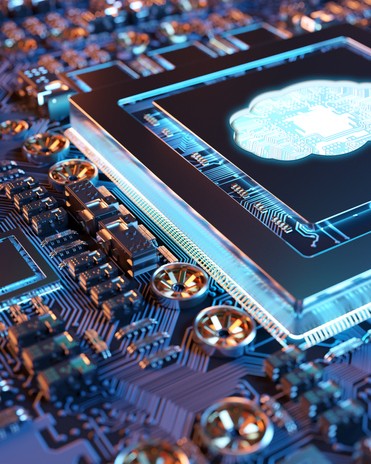MIT AI Hardware Program
2023 Symposium
Thursday, April 6, 2023 | 9:30am - 2:30pm ET
MIT Building 34-401, Grier Room
50 Vassar St, Cambridge, MA
Hybrid Event

About
The MIT AI Hardware Program is an academia-industry initiative between the MIT School of Engineering and MIT Schwarzman College of Computing. We work with industry to define and bootstrap the development of translational technologies in hardware and software for the AI and quantum age.
The symposium included project reviews of the current MIT AI Hardware Program portfolio as well as exposure to new projects.
Recorded Talks
Efficient AI Computing: from TinyML to Large Language Model Acceleration
Song Han, Associate Professor of Electrical Engineering and Computer Science
Rapid developments in silicon technology mean that what constitutes a large model today may become a tiny model tomorrow. Our work covers both tinyML research and the development of large language models, which have been integrated by the industry.
Accelerated Photonic Deep Learning: Decentralized and Single Chip Solutions
Ryan Hamerly, Research Scientist at MIT and Senior Scientist at NTT Research
The field of quantum mechanics presents significant opportunities to tackle unresolved issues in communication, computation, and precision measurement. We are working to advance these technologies in diverse physical systems, such as atoms, superconductors, and topological states of matter.
In collaboration with Dirk Englund, Associate Professor of Electrical Engineering and Computer Science
DSAIL: Building Data Systems using Learning
Sam Madden, Professor of Electrical Engineering and Computer Science
In this talk, I will describe recent progress in the Data Systems Group at MIT on using machine learning algorithms to improve the performance of large scale systems that work with data like database systems and file systems.
Ferroelectric Synapses
Yanjie Shao, PhD Candidate in Electrical Engineering and Computer Science
The recent discovery of prominent ferroelectric properties of CMOS-compatible HfO2-based materials has brought new functionality to microelectronics in the form of a new memory technology and the potential of transistors that can operate at very low voltages. An intriguing new application of these remarkable findings is in low-energy analog synapses.
In collaboration with Jesús del Alamo, Donner Professor, Professor of Electrical Engineering and Computer Science, Mac Vicar Faculty Fellow
There’s Always a Bigger Fish: A Clarifying Analysis of a Machine-Learning-Assisted Side-Channel Attack
Mengjia Yan, Assistant Professor of Electrical Engineering and Computer Science
Machine learning has made it possible to mount powerful attacks through side channels that have traditionally been seen as challenging to exploit. However, due to the black-box nature of machine learning models, these attacks are often difficult to interpret correctly. Models that detect correlations cannot be used to prove causality or understand an attack’s various sources of information leakage. In this talk, we show that a state-of-the-art website-fingerprinting attack powered by machine learning was only partially analyzed, leading to an incorrect conclusion about its root causes. We further show how a careful analysis can reveal the mechanisms behind this powerful attack.
Nonvolatile Photonic Memory for Computing
Juejun Hu, Professor of Materials Science and Engineering
Photonic hardware accelerators are gaining interest as the prevailing von Neumann computing architecture struggles with AI tasks, and chalcogenide phase change materials (PCMs) are promising due to their optical property contrast and unique behavior as a photonic memory material, enabling on-chip and free-space re-programmable optical computing network architectures with ultrahigh speed, massive parallelism, and low energy consumption.
Poster Session
Click on a poster in the virtual gallery to learn more.
